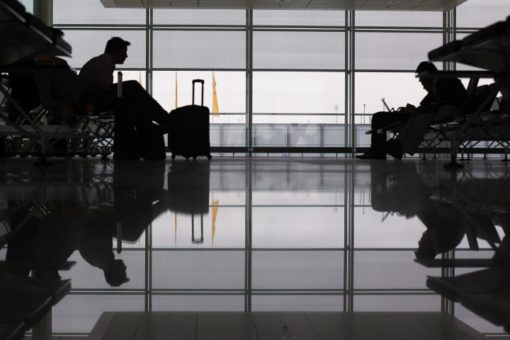We have received hundreds or even thousands of questions from travellers worldwide about the ETIAS Visa Waiver Program.
“What is the ETIAS Visa waiver?”, “Which countries need an ETIAS Visa and how can I get one?”, “What is the difference between ETIAS and Schengen Visa?, “What are the ETIAS Europe Member Countries?”
These are some of the most common questions that our community members ask.
For this reason, we have decided to create a comprehensive guide so that you can clearly understand what the ETIAS Visa Waiver is and whether you are eligible to apply for it or not.
Table of contents:
- What is the ETIAS Visa Waiver for the Schengen Area?
- ETIAS vs. Schengen Visa: 3 key differences
- What do ETIAS and Schengen Visa have in common?
1. What Is The ETIAS Visa Waiver For The Schengen Area?

ETIAS stands for European Travel Information and Authorisation System.
The ETIAS Visa waiver for Europe is an electronic travel authorisation that allows you to visit the ETIAS countries.
The ETIAS countries are actually the Schengen countries (the ones that form part of the Schengen Area).
In case you are not clear about the countries in the Schengen Area, below you will find the complete list of the Member States.
The Member States list includes:
- 23 EU countries
- 4 non-EU countries
- 3 microstates de facto part of the Schengen Area (because they maintain open borders with the Schengen countries)
22 EU Member States that form part of the Schengen Area:
| Austria | Denmark | Germany | Latvia | Netherlands | Slovenia |
| Belgium | Estonia | Greece | Lithuania | Poland | Spain |
| Croatia | Finland | Hungary | Luxembourg | Portugal | Sweden |
| Czech Republic | France | Italy | Malta | Slovakia |
4 non-EU Member States that form part of the Schengen Area:
| Iceland | Liechtenstein | Norway | Switzerland |
3 microstates de facto part of the Schengen Area:
| Monaco | San Marino | Vatican City |
Please note that the ETIAS authorisation is also valid for:
| Andorra |
Andorra is not part of the European Union or the Schengen Zone, but there has been a customs union agreement between Andorra and the EU since 1990.
Furthermore, Andorra does not have its own airport, meaning you have to access it by passing through Spain or France (two of the Member States).
Hence, the ETIAS travel authorisation allows you to enter the 30 countries mentioned above.
By the end of 2023, all travellers who do not need a Schengen Visa are expected to apply for an ETIAS Visa Waiver to enter the Schengen Zone.
The ETIAS will be a mandatory pre-condition to enter the Schengen Zone.
Therefore, the ETIAS system is not operative yet.
The European Commission will publish the date from which third country nationals will be able to submit their ETIAS applications (you can access their official website here).
The primary purpose of the ETIAS travel authorisation is to:
- Decrease security concerns by pre-screening travellers before they reach the Schengen borders
- Speed-up, reinforce, and modernise the border control procedure
- Strengthen the security in the Schengen Zone
- Protect the Schengen Zone visitors and European citizens and residents
The ETIAS system will check all applications across several security databases, such as the Schengen Information System (SIS), Visa Information System (VIS), International Criminal Police Organisation (Interpol), European Union Agency for Law Enforcement Cooperation (Europol), etc.
The ETIAS Visa Waiver for Europe will allow you to stay for up to 90 days in the Schengen Zone, but it is not a substitute for a student or work Visa.
If you need to stay in the Schengen Zone for more than 90 days, you still need to apply for a type-D National Schengen Visa that Embassies and Consulates issue under national laws and regulations.
2. ETIAS Vs. Schengen Visa: 3 Key Differences

You may ask yourself: “What are the differences between the ETIAS and Schengen Visa since both of them authorise travellers to enter the Schengen Territory?“
You are right. Both have the same purpose: allowing non-EU travellers to move freely within the Schengen Territory.
However, there are three main differences between an ETIAS travel authorization and a Schengen Visa.
- Application process
ETIAS is not a Visa, but a travel authorisation or Visa waiver, meaning you do not need to apply to an Embassy or Consulate to get it.
On the other hand, getting a Schengen Visa is a longer and more complicated process as you need to submit a list of specific required documents and wait for the Visa officers to review them.
The ETIAS application process is automated, while Schengen Visa applications are reviewed on a case-by-case basis by the Visa officers.
You can learn more about the Schengen Visa application process here.
Please also note that the Schengen Visa is a sticker that the Embassy officers affix to your passport, while ETIAS is an authorization you receive by email.
Even though the authorisation will be linked to your passport, we recommend printing it out for border control.
Besides, the Schengen Visa officers can take up to 15 working days to process an application, while the ETIAS system should process your application within minutes.

- Travellers eligible for ETIAS do not qualify for Schengen Visa (and vice versa)
The other difference between an ETIAS authorisation and a Schengen Visa is related to travellers’ citizenship.
As we mentioned previously, all travellers who need to apply for ETIAS do not need a Schengen Visa to travel to Europe (and vice versa), meaning you cannot hold both.
First, we recommend visiting this link to find out what countries are eligible for a Schengen Visa.
Below you will find a list of 59 eligible countries that need to apply for an ETIAS travel permit when travelling to the Schengen Territory (once the system becomes available).
This list may change in the future as more countries may become eligible for ETIAS.
| Albania | Chile | Israel | Moldova | Saint Vincent | Trinidad and Tobago |
| Antigua and Barbuda | Colombia | Japan | Montenegro | Samoa | Tuvalu |
| Argentina | Costa Rica | Kiribati | New Zealand | Serbia | Ukraine |
| Australia | Dominica | Macao | Nicaragua | Seychelles | United Arab Emirates |
| Bahamas | El Salvador | Macedonia | Palau | Singapore | United Kingdom |
| Barbados | Georgia | Malaysia | Panama | Solomon Islands | United States of America |
| Bosnia and Herzegovina | Grenada | Marshall Islands | Paraguay | South Korea | Uruguay |
| Brazil | Guatemala | Mauritius | Peru | Taiwan | Vanuatu |
| Brunei | Honduras | Mexico | Saint Kitts and Nevis | Timor Leste | Venezuela |
| Canada | Hong Kong | Micronesia | Saint Lucia | Tonga |
However, please note that the ETIAS requirement does not apply to:
- Family members of an EU citizen
- Holders of national long-stay Schengen Visas
- Holders of residence permits issued by a Member State
- Holders of a local border traffic permit
- Holders of diplomatic or service passports
- Required documents
Applying for a Schengen Visa means meeting several requirements that vary according to your income and funding sources, personal situation, and travel purpose.
Most of the time, collecting the Schengen Visa application required documents is a painful and long-lasting process.
On the other hand, the ETIAS application process is hassle-free as you are required to have:
- A valid passport
- An email address
- A debit or credit card to pay the application fee (7 EUR)
The ETIAS Visa Waivers will be free of charge for applicants under 18 years old.
When applying for an ETIAS, you only need to provide basic information about yourself, such as your full name, date of birth, passport details, and residency country. You may also need to answer a set of security and health questions.
Completing the application should not take more than 10 minutes. Only in limited cases where further checks are required it takes up to 30 days to get the ETIAS permit.
3. What Do ETIAS and Schengen Visa Have In Common?
Notwithstanding the differences mentioned above, ETIAS and Schengen Visa have something in common:
- Duration of stay
Both ETIAS and Schengen Visa allow you to travel to the Schengen countries for up to 90 days over a 180-day period for tourism, transit, business, or medical purposes.
Once approved, an ETIAS can be used for three years or until the passport expires.
For this reason, it is similar to a 3-year multiple-entry Schengen Visa that allows you to enter and exit the Schengen Area as many times as you want during a 3-year period, as long as you don’t break the 90/180-day rule.
- Potential denied entry at border control
Neither an ETIAS nor a Schengen Visa guarantees your entrance into the Schengen Area.
The border authorities will decide whether you can enter the ETIAS countries after the entry port screening process.
However, if you hold a valid Schengen Visa or ETIAS travel authorisation, it is less likely that the immigration authorities will ban you from entering the Schengen Area.
Therefore, you have no reason to worry about it.
- Rejection reasons
The main reasons why the ETIAS Travel Information and Authorization system can refuse your application are:
- Providing incomplete, inadequate, or inconsistent information
- Using false or misleading documents
- Having a criminal record
- Being considered a security threat for the Schengen countries
- Posing a risk to public health
- Overstaying a previous trip in Europe
- The Schengen Information System (SIS) has issued an alert on your name
- Posing an illegal immigration risk
The refusal reasons mentioned above are the same as to why your Schengen Visa can be rejected.
To read more about the Schengen Visa rejection reasons, please check out this link.
- Appeal process
In the unfortunate event that your ETIAS gets denied, you can appeal the decision.
If your Visa waiver gets denied, the system will notify you via mail.
The email will outline the rejection reason. You may be required to provide additional information or documentation.
If your ETIAS travel permit gets rejected even after providing extra documents, you still have the right to appeal the decision.
The same rule applies to a Schengen Visa refusal.
You have the right to appeal your Schengen Visa refusal and provide additional documents.

In conclusion, the ETIAS system is a security measure that will soon become operational.
According to the European Commission, “ETIAS is among the measures undertaken as part of the Security Union. It will also help achieve the objectives of the European Agenda on Security and the European Agenda on Migration in particular regarding border management and preventing cross-border crime and terrorism”.
If you are eligible for an ETIAS authorisation, your application process should be smooth and hassle-free.
But if you need a Schengen Visa to travel to Europe, you may need additional support as the application process can be burdensome.
In this case, please do not hesitate to contact us. We would be glad to provide you with a FREE Schengen Visa consultation report and help you better understand what required documents you must submit to the Embassy for a successful application.
